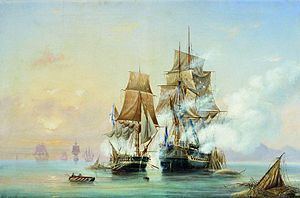Laid down 31 March 1783 Acquired 1 June 1789 Length 46 m | Namesake Venus Name Venus (Венус) Launched 19 July 1783 Beam 12 m | |
 | ||
Captured 1 June 1789 by the Imperial Russian Navy | ||
Venus was a Swedish frigate, designed by Fredrik Henrik af Chapman. Venus was captured by the Russians in 1789 in Oslofjord. The frigate retained the same name in Imperial Russian service until 1807, when she was sold to the Kingdom of Naples.
Contents
Service history
Venus was launched on 19 July 1783 in Karlskrona. In 1786 she sailed to Gothenburg where she was to be subordinated the local naval station, which was commanded by Adolf Ulrik Sheldon. Three years later, on 1 June 1789, while she was under the command of Major Magnus Hansson, and belonged to the Gothenburg squadron, she was conquered by the Russians in a complicated action that created an interesting legal and diplomatic aftermath.
Capture by the Imperial Russian Navy
On 1 June 1789, Venus was patrolling the waters outside the Norwegian coast, Norway at this time was ruled by Denmark and considered neutral. On 31 May the lookouts reported a Russian squadron of four frigates and a cutter, the report was soon corrected to two ships of the line, two frigates and a cutter.
Relying on his ships excellent sailing abilities Commander Hansson expected to be able to stay ahead of the Russian ships until a change in the wind suddenly bereaved him of the possibility to reach open sea. Cornered by the Russians, the ship escaped into the entrance of the fjord of Christiania (presently Oslo), expecting the protection of a neutral nation. However the Russian ships followed and went into action, the cutter Merkuriy was the first to reach Venus and both ships opened fire. The larger ships then followed, positioning themselves to be able to fire along the lengths of Venus.
Hansson had prepared his ship with spring on the anchor cables to enable to train his ship's guns sideways and initially he managed to damage first arriving Russian ships. However, when the capital ships was in place and also opened fire Commander Hansson, after consultation with his senior officers concluded that nothing more could be achieved by further bloodshed and hauled down his colours. According to a testimony from the Danish/Norwegian pilot, Commander Hansson right after hauling down his flag boarded the Russian flagship claiming the attack as a crime of war.
The hard feelings among Swedish officers was also obvious in other official reports. The squadron commander A.F. Rosensvärd mentioned in his official report about the loss of Venus that his ships had respected the neutrality versus Russian ships in Danish harbours, "...ships that I with my superiour force easily could have captured if it had been within legal practice...".
The Russian newspapers and authorities made the outmost of the capture spreading the news that Venus had hauled down her colours to the 22-gun cutter Merkuriy. The imprisoned Commander Hansson reacted furiously claiming his honour as officer had been questioned and wrote a letter to the commander of the Russian squadron asking him as a gentleman to testify about the events.
Commander Jenkins of the cutter Merkuriy answered the call from his enemy colleague. In a letter that can still be found of the Swedish court protocols he not only confirmed that Commander Hansson did actually haul down his flag to the squadron, but also claims his ship suffered severe damages and would have been sunk if the larger ships had not come to his assistance.
Upon returning from captivity Commander Major Hansson was placed on trial at the royal court in Stockholm in July 1791 for the loss of his ship. The relatively mild sentence of loss of a half year salary for positioning his majesty’s frigate Venus into a position where he could not escape to the open sea indicated that the court not considered the loss itself as a crime and accepted the fact that Major Hansson should have been able to expect a safe heaven on neutral waters, and that his defence of the ship had been sufficient until the point of the arrival of the full Russian squadron.
Service with Russia and Naples
The ship was taken over by the Russian Navy and participated in the battle of Reval and in the battle of Vyborg Bay in 1790 under the command of the British Admiral Roman Crown. Venus visited Holland in 1795 and Great Britain in 1795–1797 and 1799–1800. She served in the Adriatic Sea between 1805 and 1807 and in the Aegean Sea in 1807. She was sold to the Kingdom of Naples in Palermo to avoid capture by the British.
